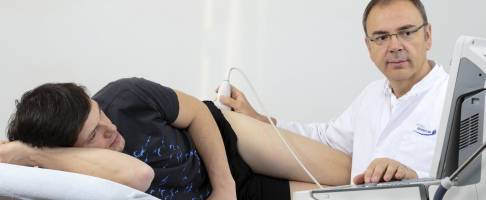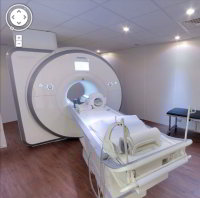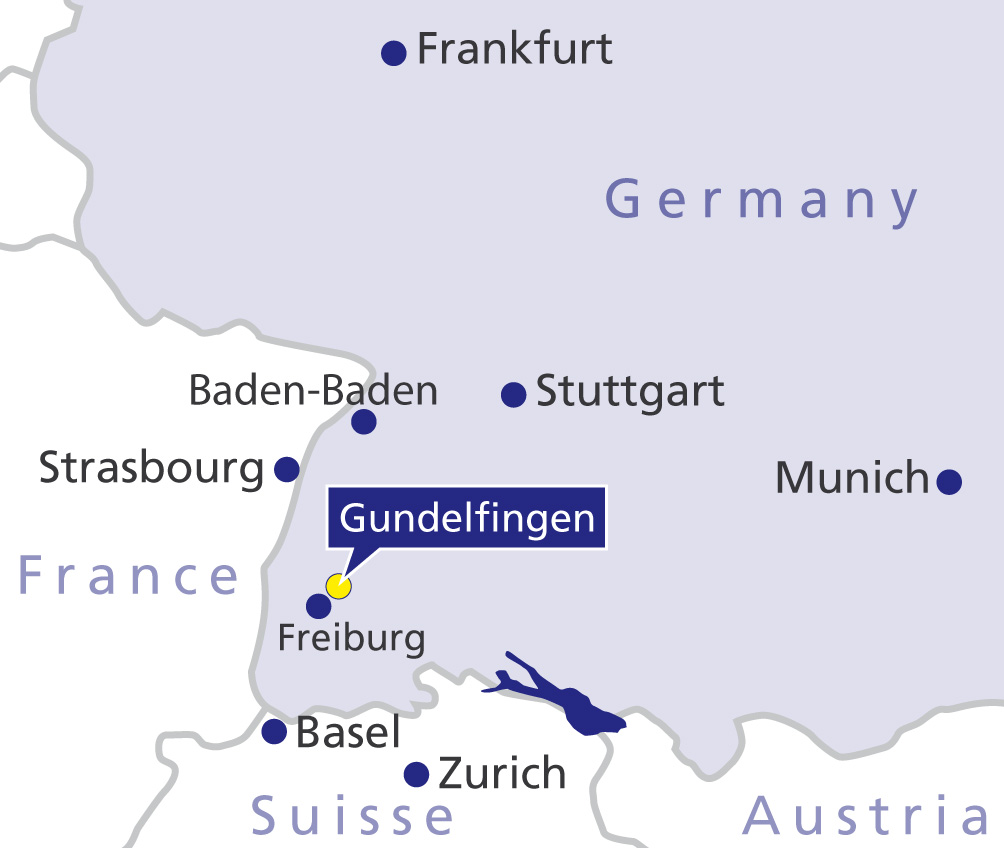Femoral Head Necrosis: Consequences of Cortisone Treatment?
- Causes of femoral head necrosis
- When is femoral head surgery necessary?
- What happens before operating on femoral head necrosis?
- What happens during femoral head necrosis surgery?
- Which type of physician operates on an osteonecrosis of the femoral head?
- What type of anaesthesia is used for femoral head surgery?
- Aftercare, rehabilitation and aids after operating on femoral head necrosis
- Should I expect pain after femoral head surgery?
- What will my stay be like at Gelenk-Klinik?
- What do I need to keep in mind after femoral head surgery?
- Cost of femoral head surgery
- How can international patients schedule femoral head surgery?
 The pain in the hip and groin increases gradually with femoral head necrosis. © freeograph, Adobe
The pain in the hip and groin increases gradually with femoral head necrosis. © freeograph, Adobe
Femoral head necrosis refers to the death of living bone tissue in the hip joint. Due to reduced blood flow, the hip bone demineralises and loses its stability. Those affected feel pain in the groin during exertion, mainly when the leg is rotated inwards. In later stages, the pain occurs at rest as well.
Femoral head necrosis in adults appears to be a typical disease of civilisation. Similar to cardiac infarction, hip infarction is also caused by risk factors such as smoking, high blood lipid levels and excessive alcohol consumption. Another risk factor that has become increasingly important in recent years is treatment with cortisone, especially when administered intravenously.
Femoral head necrosis occurs primarily in patients between 35 and 45 years of age. Men are more frequently affected than women. Death of the femoral head extremely reduces the quality of life of those affected. Femoral head necrosis is bilateral in 30-70% of cases. If treatment is not administered at an early stage, irreparable damage to the hip joint can occur, leading to accelerated hip osteoarthritis, even though the cartilage itself is not directly affected by the circulatory disorder.
Causes of femoral head necrosis
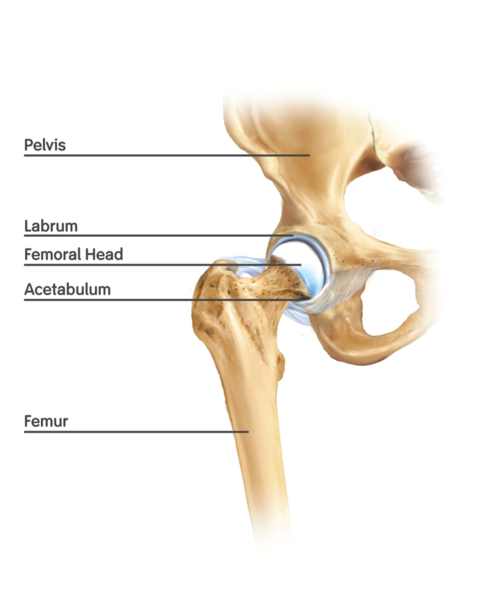 Basic anatomy of the hip joint. ©Wikipedia.org
Basic anatomy of the hip joint. ©Wikipedia.org
- Accident-induced injuries with damage to the femoral head vessels, such as after a femoral neck fracture close to the femoral head (post-traumatic femoral head necrosis)
- Osteochondrosis of the hip joint with damage to the bone and cartilage
- Alcohol-induced damage to the femoral head (ethyltoxic femoral head necrosis)
- Radiation-induced damage to the femoral head (post-radiation femoral head necrosis)
- Cortisone-induced damage to the bone (glucocorticoid-induced femoral head necrosis)
- Cytostatic drugs (chemotherapeutic agents) with bone-damaging effects
- Diving injuries caused by gas bubbles when ascending too quickly (Caisson’s disease or decompression sickness)
- Occupational disease in divers and miners
- Metabolic circulatory disorders of the femoral head (elevated bile acid, elevated blood sugar in diabetes mellitus, lipometabolic disorder)
- Hip disease as a result of kidney disease (renal femoral head necrosis)
- Coagulation disorders
- Blood cell tumours
Despite the many modern diagnostic methods and the wealth of studies conducted, not all causes of femoral head necrosis are yet known. Patients who have a circulatory disorder of the femoral head and all the signs of femoral head necrosis but do not have any of the above-mentioned causes regularly come to consult us.
When is femoral head surgery necessary?
The treatment decision is based on the ARCO classification (ARCO = Association Research Circulation Osseous). The age of the affected patient and the extent and location of the femoral head necrosis are decisive classification factors. Autonomous repair of bone necrosis through conservative treatment is rather unlikely in adults. During childhood and adolescence, where the condition is referred to as Perthes’ disease, the chance of autonomous healing is significantly higher. Children’s bones have a more robust repair mechanism than those of adults, which means that stronger remodelling reactions are to be expected.
The condition of the hip joint, the general condition and life expectancy of the patient and comorbidities are factored in when making the treatment decision.
The less advanced the bone necrosis, the better the chances of alleviating the symptoms and even achieving complete healing. In later stages, surgery is usually the only way to treat femoral head necrosis and preserve the hip joint. If the surface of the hip joint has collapsed due to necrosis, only an artificial hip joint will be able to restore pain-free mobility of the hip.
What happens before operating on femoral head necrosis?
Before the operation, the physician performs a comprehensive clinical diagnosis. Essentially, the hip specialist can already diagnose femoral head necrosis based on the symptoms described and the physical examination.
Using digital X-rays, MRI and CT, the orthopaedic surgeon can precisely analyse the type and extent of the hip necrosis to develop a treatment plan tailored to the patient’s needs.
What happens during femoral head necrosis surgery?
To decide which operation is most promising for femoral head necrosis, it is necessary to determine the stage of the disease. We are guided by the ARCO classification (ARCO = Association Research Circulation Osseous). According to this classification, a collapse of the femoral head occurs during the transition from stage II to stage III.
If this is the case, the use of joint-preserving treatments on the hip joint is no longer expedient. Before the femoral head collapses (ARCO: stage I and stage II of femoral head necrosis), joint-preserving operations such as femoral head drilling and realignment surgery can support the healing process.
Drilling of the femoral head
![Drilling the femoral head reduces the pressure in the bone. This allows blood circulation to be restored. © Gelenk-Klinik [Joint Clinic] Cannula in the femoral head](/orthopedic-joint-surgeon/hip-surgery/drilling-femoral-head.jpg) Drilling the femoral head reduces the pressure in the bone. This allows blood circulation to be restored. © Gelenk-Klinik [Joint Clinic]
Drilling the femoral head reduces the pressure in the bone. This allows blood circulation to be restored. © Gelenk-Klinik [Joint Clinic]
In the early stages, drilling (core decompression) of the necrosis area with possible removal of the necrosis is a proven method of treating femoral head necrosis. This measure aims to reduce the pressure on the bone tissue to restore blood circulation. At the same time, the drilling stimulates the formation of new blood vessels in the necrotic area.
Repositioning of the femoral head (osteotomy)
Surgical repositioning of the femoral head seeks to rotate the damaged bone parts of the hip joint out of the stress zone. The orthopaedic surgeon must cut through the thigh bone (femur) completely.
This reduces the shear forces on the femoral head, thereby reducing the extent to which the repair mechanisms are hindered. As this involves a complex procedure, the indication for surgery needs to be strictly defined.
Joint replacement in ARCO stage III and stage IV femoral head necrosis
Once stage III has been reached, femoral head necrosis can only be treated with artificial joint replacement.
It is usually the case that very young patients develop femoral head necrosis. For this reason, it is important to choose a hip prosthesis with as many options for replacement as possible, as a prosthesis usually does not last for a lifetime. One option is surface replacement of the hip joint according to McMinn (hip-cap prosthesis). This gentle type of joint replacement merely crowns the femoral head instead of removing it completely.
Which type of physician operates on an osteonecrosis of the femoral head?
Here at Gelenk-Klinik we believe a close relationship between the physician and their patient is important. Meaning, you will be in the care of your treating physician from the initial appointment until after the hip surgery. This physician is also responsible for your after-care. So, you will have one contact person who will be assigned to you throughout your stay at Gelenk-Klinik. Our hip specialists are Dr. Martin Rinio and Prof. Dr. Lukas Konstantinidis.
What type of anaesthesia is used for femoral head surgery?
Femoral head surgery is performed under general anaesthesia. The anaesthetist will inject a combination of anaesthetics individually tailored to your body. You will feel no pain during the surgery and will not be aware of the procedure. An experienced anaesthetist will be present throughout the procedure, monitoring your vital functions and ensuring you do not wake up during the surgery.
Aftercare, rehabilitation and aids after operating on the femoral head
You will already get up on your feet for the first time with assistance on the day of the operation. However, you can only apply partial weight bearing to your hip joint after drilling, which is why you will be given crutches for about six weeks. Thrombosis prophylaxis in the form of injections is also necessary during this period of partial weight bearing. Moreover, you should also wear compression stockings until you are ready for full weight bearing again. While planning for the operation, we will make sure that you will be provided with the aids you need after the operation.
About three months after the procedure, we will check the success of the treatment with an MRI. Only then will we be able to assess whether the blood circulation in the femoral head has permanently improved.
The situation is different after implantation of a hip prosthesis: You will commence with full weight bearing immediately after the operation. However, the weight bearing of the hip should be supported with crutches for 4 to 6 weeks.
We will check the correct position of the hip prosthesis 6 months after the operation and once a year from then on.
Should I expect pain after femoral head surgery?
Every surgical procedure may cause pain. We always try to minimise pain as much as possible. The anaesthetist often uses a so-called nerve block before the surgery, numbing the respective hip for about 30 hours. This already manages the immediate wave of pain after surgery, which can then be easily treated with regular medication. Our goal is for you to experience as little pain as possible.
What will my stay be like at Gelenk-Klinik?
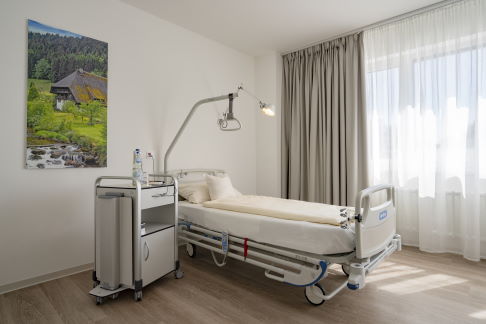 Private room in the Gelenk-Klinik in Gundelfingen, Germany. © joint-surgeon
Private room in the Gelenk-Klinik in Gundelfingen, Germany. © joint-surgeon
During your inpatient stay at Gelenk-Klinik you will have a single-occupancy room. The room has a bathroom with shower and WC. All rooms include towels, a bathrobe and slippers. They further include a mini-bar and safe. All rooms also have a television. You only need to bring your personal medication, comfortable clothes and sleepwear. After surgery you will receive 24-hour care from experienced nursing staff, international patient care team and experienced physiotherapists. The inpatient stay following the procedure typically lasts 3 days. Your family members can stay at a hotel within walking distance (300 m). We will help you to make the reservations.
What do I need to keep in mind after femoral head surgery?
To avoid complications, the hip should not be subjected to full weight bearing for a few weeks after the operation. You will receive crutches for a total of 6 weeks. For the first 4 weeks, you may only apply partial weight bearing of 10 kg to your hip joint. How long you will remain incapable of working depends on your professional activity and may last up to 12 weeks. We will provide you with a doctor’s certificate for this period. Thrombosis prophylaxes are imperative during the time you are unable to put your full weight on your leg. Extensive physiotherapy is very important during this stage to prevent muscle loss and maintain the function of the knee.
You should plan your return flight at least 10 days after surgery. Ideally, we recommend scheduling your return flight after about 14 days.
- Inpatient treatment: 3–5 days
- Optimal local stay: 10–14 days
- Earliest return flight: 10 days after surgery
- Recommended return flight: 12–14 days after surgery
- Showering permitted: 5 days after surgery
- Recommended time off work: 6–12 weeks (depending on your job)
- Recommended removal of stitches: 10 days
- Outpatient physical therapy: 2 weeks
- Driving permitted: 8 days after surgery
- Light sporting activity: 8 weeks after surgery at the earliest
- Normal sporting activity: 6 months after surgery
Cost of femoral head surgery in Germany
In addition to the cost of hip surgery, you will also need to plan for additional costs for diagnostics, physician’s appointments and aids (e.g. crutches). These will be about 1,500 to 2,000 Euro. If you plan to have outpatient physiotherapy after surgery, we will gladly send you an estimate of costs.
You will find information about the cost of hotel lodging and any follow-up treatment at the rehabilitation clinic on the websites of the respective providers.
How can international patients schedule femoral head surgery?
We will first need recent MRI images and X-rays to medically assess the condition of your hip. After sending these to us through our website, we will send you patient information and a binding estimate of costs within 1–2 days.
Gelenk-Klinik offers quick appointments to accommodate your preferred travel itinerary. We will gladly help you apply for a visa once we have received the down-payment specified in the cost estimate. If the visa is denied, we will refund the full down-payment.
We try to minimise the time between the preliminary examination and the surgery for our international patients to avoid additional travel. During your inpatient and outpatient stay our multi-lingual (English, Russian, Spanish, Portuguese) case management team will be there to assist you. We can also provide an interpreter (e.g. Arabic) at any time, at the patient’s expense. We will gladly assist you with organising transportation and lodging and provide tips for recreational activities for your family members.
